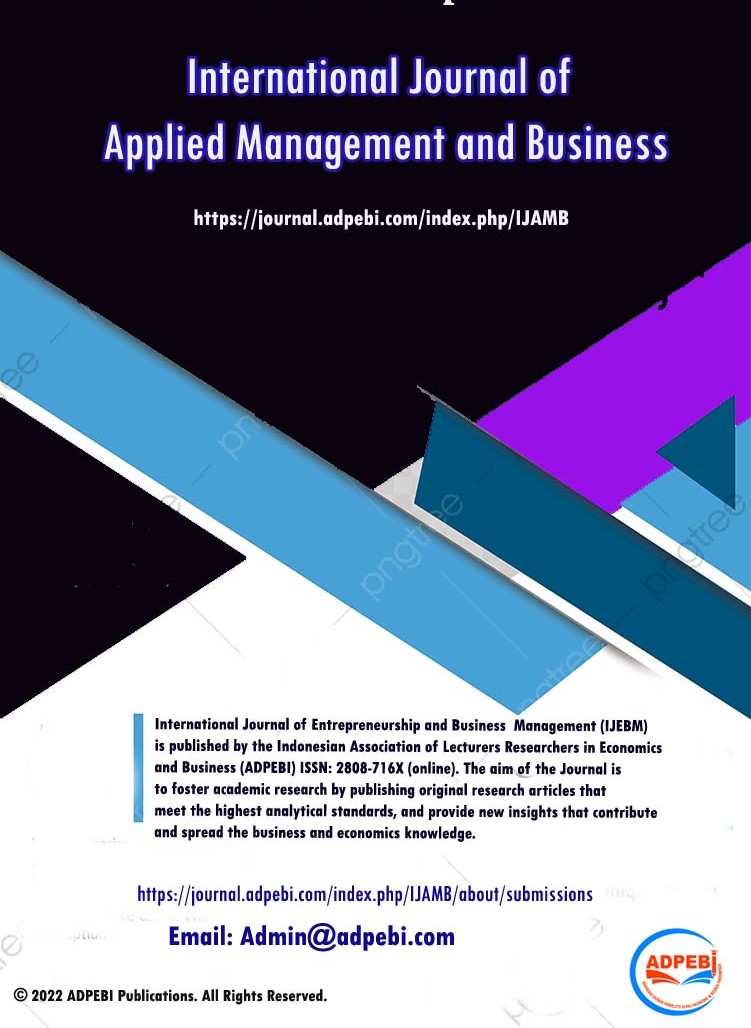Model Analysis of Intention to Using Tije Mobile Applications For Transjakarta Users
DOI:
https://doi.org/10.54099/ijamb.v1i2.680Keywords:
Perceived convenience , perceived usefulness, social influence, attitude, intention to useAbstract
Purpose – This This study aims to determine and analyze the intention model using the Tije mobile application for Transjakarta users. In several previous studies, it was found that attitude mediates perceptions of convenience, perceived usefulness, and social influence on intention to use.
Methodology/approaches –The method used in this study is quantitative and descriptive causal research methods. The research hypothesis testing was carried out using the Partial Least Square (PLS) based Structural Equation Model (SEM) approach.
Findings – It The results showed that independently, the variables perceived convenience, perceived usefulness and social influence had a positive influence on the intention to use the Tije mobile application. The attitude variable also has a positive and significant influence on the intention to use. The three independent variables are mediated by attitudes which have a positive and significant influence on the intention to use.
References
Akbar Niko Faizal &Nurmadi Adi, (2019). Analysis of Perceived Usefulness, Perceived Ease of Use and Service Quality on User Satisfaction in Using Snaapp Communication Application in Ignatius Slamet Riyadi Karawang Elementary School. Saudi Journal of Business and Management Studies.
Alanza, Z., Loveldy, C., Ahmad, T., Ismail, T., & Siti, S. (2021). Examining the Attitude- Behavior Gap and Adoption Intention of SHS Technology : The Role of Social Influence. 3(1), 14–24.https://doi.org/10.35313/ijabr.v3i1.119.
Alfany, Z., Saufi, A., & Mulyono, L. E. H. (2019). The Impact of Social Influence, Self-Efficacy, Perceived Enjoyment, and Individual Mobility on Attitude toward use and Intention to use Mobile Payment of OVO. Global Journal of Management and Business Research: E Marketing, 19(7), 1–8.
ALraja, M. N., & Aref, M. (2015). Customer acceptance of e-commerce: Integrating Perceived Risk with TAM. International Journal of Applied Business and Economic Research, 13(2), 913–921.
Bailey, A. A., Pentina, I., Mishra, A. S., & Ben Mimoun, M. S. (2017). Mobile payments adoption by US consumers: an extended TAM. International Journal of Retail and Distribution Management, 45(6),626–640. https://doi.org/10.1108/IJRDM-08-2016-0144
Boontarig, W., Chutimaskul, W., Chongsuphajaisiddhi, V., & Papasratorn, B. (2012). Factors influencing the Thai elderly intention to use smartphone for e- services. SHUSER 2012 - 2012 IEEE Symposium on
https://doi.org/10.36348/sjbms.2019.v04i11.005
Imam, S. F., & Astini, R. (2022). The Effect Of Green Transformation Leadership On Government Performance Accountability: Through Organizational Learning. International Journal of Law Policy and Governance, 1(1), Article 1. https://doi.org/10.54099/ijlpg.v1i1.194
Iskamto, D. (2017). Metodologi Penelitian (1st ed.). PT Victory Intimultiya.
Iskamto, D. (2020). The Role of Leadership and Influence on Employee Performance in Digital Era. Jurnal Manajemen Bisnis, 17(4), 470–484.
Iskamto, D., & Ghazali, P. L. (2021). Framework of Mediating Role of MSEs Performance On The Relationship Between Entrepreneur Environment and Entrepreneur Satisfaction. The Journal of Management Theory and Practice (JMTP), 71–73. https://doi.org/10.37231/jmtp.2021.2.2.118
Iskamto, D., Karim, K., Sukono, & Bon, T. (2020). Impact of Employee Satisfaction on Work Discipline in Government Office in Indonesia. The International Conference on Industrial Engineering and Operations Management, 13.
Makdori Yopi, Liputan 6, 2022, Transjakarta Luncurkan Aplikasi TIJE Versi Baru yang Lebih Ramah Prokes Covid19. https://www.liputan6.com/news/read/4476164/transjakarta-luncurkanaplikasi Tiara Aliya Azzahra, detik news, 2022 Baca artikel detiknews, "Penumpang TransJakarta Capai 800 Ribu Per Hari". https://news.detik.com/berita/d-6360693/penumpang-transjakarta- capai-800-ribu-per-hari.Cindy Mutia Annur, Kata Data, 2022, Jumlah Penumpang Transjakarta (2017-2021).https://databoks.katadata.co.id/datapublish/2022/09/27/imbas-pandemi-covid-19-jumlah-penumpang-transjakartamerosottajam#:~:text=Kemudian%20jumlah%20penumpang%20Transjakarta%20menurun,81%2 0juta%20orang%20pada%202021
Nisa, K., & Putri, A. (2022). The Effect of Accountability and Transparency on the Effectiveness of Fund management BOP With Parental Participation As Moderating Variables. Adpebi International Journal of Multidisciplinary Sciences, 1(1), Article 1. https://doi.org/10.54099/aijms.v1i1.228
Pikkarainen, T., Pikkarainen, K., Karjaluoto, H., & Pahnila, S. (2004). Consumer acceptance of online banking: An extension of the technology acceptance model. Internet Research, 14(3), 224–235.https://doi.org/10.1108/10662240410542652
Purwanto, E., & Loisa, J. (2020). The intention and use behaviour of the mobile banking system in Indonesia: UTAUT model. Technology Reports of Kansai University.
Sharma, S. K. (2019). Integrating cognitive antecedents into TAM to explain mobile banking behavioral intention: A SEM-neural network modeling. Information Systems Frontiers, 21(4), 815–827. https://doi.org/10.1007/s10796-017-9775-x
Sigar, J. F. (2016). the Influence of Perceived Usefulness, Perceived Ease of Use and Perceived Enjoyment To Intention To Use Electronic Money in Manado. Jurnal EMBA: Jurnal Riset Ekonomi, Manajemen, Bisnis Dan Akuntansi, 4(2), 498–507. https://doi.org/10.35794/emba.v4i2.13083.
Suki, N. M., & Ramayah, T. (2010). User acceptance of the e-Government services in Malaysia: Structural Equation Modelling approach.
Zayyad, M. A., & Toycan, M. (2018). Factors affecting sustainable adoption of e- technology in developing countries: An exploratory survey of Nigerian hospitals from the perspective of professionals. PeerJ, 2018(3). https://doi.org/10.7717/peerj.4436.
Zhao, J., Fang, S., & Jin, P. (2018). Modeling and quantifying user acceptance of personalized business modes based on TAM, trust and attitude.Sustainability (Switzerland), 10(2), 1–26. https://doi.org/10.3390/su10020356.
Downloads
Published
How to Cite
Issue
Section
License
Copyright (c) 2023 International Journal of Applied Management and Business

This work is licensed under a Creative Commons Attribution-NonCommercial 4.0 International License.










